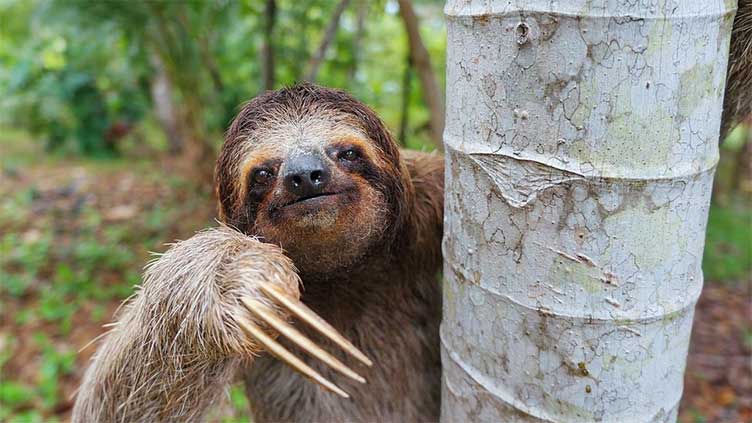Scientists are baffled as to why sloths are stronger on their left side

WeirdNews
Scientists are baffled as to why sloths are stronger on their left side
(Web Desk) - When you consider that sloths spend their entire lives practically hanging from trees by their bony fingernails, it makes sense that they are stronger than their adorable, goofy grins would lead you to believe.
Strangely, sloths appear to have stronger left sides than right sides despite using all four limbs to grasp onto branches. The first ever attempt to precisely gauge the power of a brown-throated three-toed sloth led to the discovery of this by anatomist Melody Young of the New York Institute of Technology and her colleagues.
Few mammals, especially those that just eat leaves, are designed for a life nearly entirely spent in the canopy. Although there will never be a lack of food, it is difficult to extract adequate nutrients from the fibrous plant material.
A big digestive tract helps many animal folivores, or leaf eaters, like giraffes and moose, get over this issue. However, not all mammals can afford to gain weight in ways that aid in processing hard, nutrient-deficient plant materials. Other mammals, like the koala, make do with what they can find rather than relaxing amid the branches and wasting their little energy.
The elongated bone claws of the sloth provide them with a similar means of holding securely without spending body bulk and energy on muscle force. The grip strength behind this slow dangle is great for the task, according to this recent study.
Young told New Scientist that it takes two researchers—one for each leg—to free a sloth that is clutching a third. Additionally, some sloths have been observed hanging onto trees after they have passed away.
Five brown-throated sloths were used in the measurement of this strong grasp by Young and colleagues (Bradypus variegatus). They discovered that, compared to humans and other primates, sloths, with an average body weight of 3.8 kilogrammes (8.4 pounds), have around twice the strength in their digital flexor muscles.
The lazy fuzzballs had no discernible difference between fore and rear limbs, and could readily support more than 100% of their entire weight with just one hand or foot. Contrarily, primates have stronger hind limbs, which support between 50 and 70 per cent of their body weight even when ascending. Additionally, sloths tend to carry their weight more evenly.
However, their grip strength, particularly in their hands, varied between their left and right sides by up to 16 per cent. The right side of primates like ourselves, however, tends to be stronger.
However, their grip strength, particularly in their hands, varied between their left and right sides by up to 16 per cent. The right side of primates like ourselves, however, tends to be stronger.
Future research should investigate the possible ecological and physical consequences of such a discovery, the team says. “The constant trend towards left-sidedness among the individuals studied was unexpected.”
Given the limitations of their experimental setting, Young and colleagues believe they may have even overestimated the sloth’s grasp.
According to anecdotal comments from conservation team members, B. variegatus grips onto its substrates so firmly that the skin on its back would sooner be peeled away if predators tried to take them away.
By any animal’s standards, let alone for such a slow-moving creature with an absurdly low metabolism, that is a tremendous amount of strength.
The Journal of Zoology published the results of this study.

